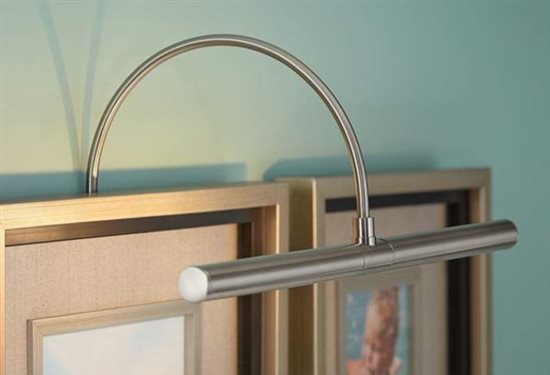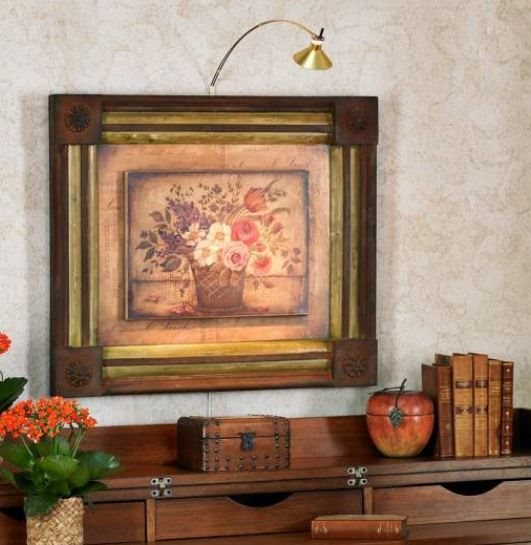How to Buy Picture Lights – A Bright Idea for Artwork

Illuminating paintings and photographs can seem like a daunting task. But don’t worry! With these simple picture lighting tips, your walls can be as well-lit as the Louvre.
Here, what you need to know before purchasing picture lights:
- What Size Picture Light Do I Need?
- How to Position Picture Lights
- How to Install Picture Lighting – Wall Mount vs. Frame Mount
- Three Power Sources of Picture Lights
- Picture Light Bulb Types

What Size Picture Light Do I Need?
Follow these three simple steps to find the right size light for you. For best results, use the sizing table shown below:
- Measure the width of your art. If framed, include in the frame as well.
- If you are using a light with a slim, small profile, you may have to go slightly larger in order to cover the entire piece.
- For unusually tall art, consider using a picture light that extends further out from the wall to ensure the light reaches down across the entire piece.
| Artwork Width | Approximate Light Width |
| 8″ to 14″ | 4 1/2″ |
| 12″ to 18″ | 5 1/2″ |
| 16″ to 24″ | 7″ to 9″ |
| 18″ to 35″ | 10″ to 13″ |
| 25″ to 37″ | 14 1/2″ to 16″ |
| 38″ and up | 30″ or use multiple lights |
With most art, using the correct width light will generally illuminate the entire surface adequately.
Buying Tip – When you are browsing our picture light collection, use the choices in our Size menu to easily find the width-size you need.

How to Light Paintings and Artwork – Quick Tips
Use these expert art lighting techniques and tips to illuminate paintings and other works with picture light fixtures.
- Focus the beam on the center of the artwork, approximately at eye level.
- Make sure the beam extends to the top and bottom of the frame equally.
- Pay attention to the angle of the light:
- Shining too straight onto the artwork can result in glare.
- Shining from too extreme of an angle can cast long shadows.
- For best results, the light should be placed at a 30-degree angle from the art you intend to illuminate.
- Designer Tip! Consider using LED lights which do not emit UV rays that can fade or damage art and photographs.
How to Install Picture Lighting – Wall Mount vs. Frame Mount
- Wall mounted picture lights are installed directly onto the wall above the artwork. They provide a permanent, professional look.
- Frame mounted picture lights mount onto the picture frame itself. This feature allows you to reposition your artwork as desired without having to re-install the lighting around it.
- Designer Tip! Not sure which type is best for your needs? Many designs can be both wall and frame mounted.
Three Power Sources of Picture Lights
- Plug-In picture lights plug into any outlet, just like a regular lamp. Because of this, they can be easily repositioned as needed. Try adding a cord cover to conceal the power cord for a finished look.
- Direct Wire picture lights are hardwired into your home’s electrical feed, lending a clean and permanent look.
- Battery Operated picture lights use battery power, making them easy to relocate and ideal where other power sources aren’t readily available. Like direct wire designs, they have no visible wires for a cleaner look.
Picture Light Bulb Types
After you’ve narrowed down your choice of size and features, you’ll also want to consider the type of bulbs that are used in the picture lights you are considering. Here, four types of picture light bulbs:
1. LED Picture Lights: These designs have a bright light, are energy efficient and will last for years. LED picture lights do not emit UV light that can harm prints, photos, and other artwork, and have a low heat output. LEDs with a high CRI (Color Rendering Index) of 80+ are best at not altering the color appearance of artwork.
Buying Tip: Remember to shop for LEDs based on the lumens (light output), not the amount of watts/energy used.
2. Incandescent: These picture lights have a warm light ideal for artwork in tones of reds, browns, and yellows.
3. Halogen: This type of light bulb has a bright white light that’s good for illuminating a broad range of colors.
4. CFLs: These light bulbs output the same amount of light as incandescent bulbs, but use 75 percent less energy.
Additional Lighting Options
Light paintings easily with picture lights. They offer an attractive and intimate look for most artwork. For sculptures or very large paintings, however, you may want to consider recessed lighting or track lighting which are able to illuminate larger areas.
